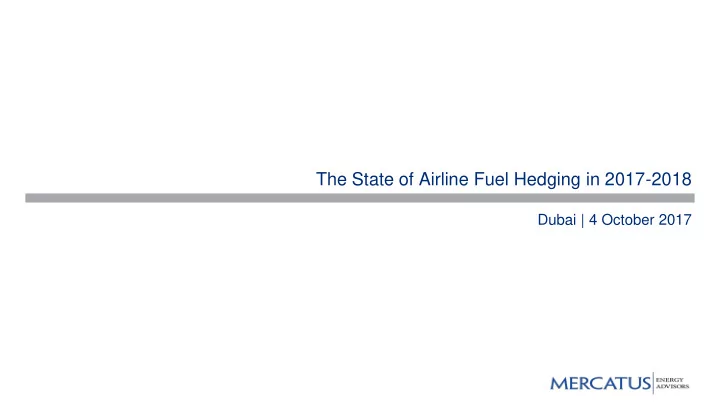

The State of Airline Fuel Hedging in 2017-2018 Dubai | 4 October 2017
Number of Aircraft in Fleet 2016-2017 2017-2018 35% 30% 25% 20% 15% 10% 5% 0% 1-25 26-50 51-75 76-100 100 or more
Majority of Flights Domestic or International 2016-2017 2017-2018 90% 80% 70% 60% 50% 40% 30% 20% 10% 0% Domestic International
Point of Origin of Majority of Flights 2016-2017 2017-2018 70% 60% 50% 40% 30% 20% 10% 0% Africa Asia Pacific & Europe Latin America Middle East North America Oceania
Majority of Shares are Publicly Traded, Privately Held or Government Owned 2016-2017 2017-2018 45% 40% 35% 30% 25% 20% 15% 10% 5% 0% Publicly Traded Privately Held Government Owned
Percentage of Total Costs Attributed to Fuel Costs 2016-2017 2017-2018 50% 45% 40% 35% 30% 25% 20% 15% 10% 5% 0% 1-25% 26-35% 36-45%
Does Your Company Engage in Fuel Hedging 2016-2017 2017-2018 90% 80% 70% 60% 50% 40% 30% 20% 10% 0% Yes No
Does Your Company Have A Formal Fuel Hedging Policy 2016-2017 2017-2018 100% 90% 80% 70% 60% 50% 40% 30% 20% 10% 0% Yes No
Primary Purpose of Your Fuel Hedging Program 2016-2017 2017-2018 50% 45% 40% 35% 30% 25% 20% 15% 10% 5% 0% Manage cash flow Ensure budget Manage exposure to Manage exposure to Other volatility certainty short-term fuel long-term fuel prices prices
Primary Decision Maker Regarding Fuel Hedging Activities 2016-2017 2017-2018 60% 50% 40% 30% 20% 10% 0% Board of Executive Risk CEO, MD or CFO, VP Risk Manager Directors Management Management President Finance or Team Committee Treasurer
What Hedging Strategies Do You Employ On A Regular Basis 2016-2017 2017-2018 90% 80% 70% 60% 50% 40% 30% 20% 10% 0% Futures Forwards Swaps Call Options Costless Three-Way Other (Physical) Collars Collars
Maximum Tenor (Duration) of Your Fuel Hedging Positions 2016-2017 2017-2018 60% 50% 40% 30% 20% 10% 0% 1-6 Months 7-12 Months 13-18 Months 19-24 Months 25 Months or More
Percentage of Fuel Consumption Hedges for Upcoming 12 Months 2016-2017 2017-2018 45% 40% 35% 30% 25% 20% 15% 10% 5% 0% 1-20% 21-40% 41-60% 61-80% 81-100%
Percentage of Fuel Consumption Hedges for Upcoming 12 Months 2016-2017 2017-2018 45% 40% 35% 30% 25% 20% 15% 10% 5% 0% Brent Crude WTI Crude Oil Singapore Jet US Gulf Coast Rotterdam Jet NY Ultra-Low ICE Gasoil Oil Fuel Jet Fuel Fuel Sulfur Diesel
Do You Believe Credit Issues May Limit Your Ability to Hedge in Coming 12 Months 2016-2017 2017-2018 100% 90% 80% 70% 60% 50% 40% 30% 20% 10% 0% Yes No
Do You Clear Any of Your Fuel Hedges with Exchanges i.e. CME, ICE? 2016-2017 2017-2018 100% 90% 80% 70% 60% 50% 40% 30% 20% 10% 0% Yes No
Primary Counterparty or Clearing Firm 2016-2017 2017-2018 100% 90% 80% 70% 60% 50% 40% 30% 20% 10% 0% Global Financial Local/Regional Major Oil Fuel Supplier Commodity Futures Clearing Institution Financial Company Trading Firm Institution Company
How Do Stakeholders (i.e. Board, Shareholders) Define Hedging Success 2016-2017 2017-2018 60% 50% 40% 30% 20% 10% 0% Minimize Minimize Cash flow Hedging Hedging Hedging results exposure to exposure to volatility is activities activities in fuel price short-term fuel long-term fuel minimized improves our provides which is at or price increases price increases bottom line competitive below budget advantage
How Can Company Best Improve Hedging Results 2016-2017 2017-2018 60% 50% 40% 30% 20% 10% 0% Strategies which A policy which Methodology Decision making Better execution Content with the better reflect the requires hedging which framework and current state company’s risk on a consistent consistently based on implementation basis, regardless seeks to quantitative of existing tolerance & goals of market optimize existing analysis of hedging policy & positions relevant data strategies.
Does Your Company Utilize Hedging Accounting per IFRS or GAAP? 2016-2017 2017-2018 90% 80% 70% 60% 50% 40% 30% 20% 10% 0% Yes No Not Applicable
What Technology Do You Use to Manage Fuel Hedging Activities? 2016-2017 2017-2018 40% 35% 30% 25% 20% 15% 10% 5% 0% Spreadsheet Treasury System Commodity Risk Financial Risk Enterprise Custom Built Management Management Platform System System System
Will Changing Market Regulations (i.e. MiFID) Impact Fuel Hedging Activities? 2016-2017 2017-2018 70% 60% 50% 40% 30% 20% 10% 0% Yes No Unsure
Primary Source of Fuel Hedging Data and Information 2016-2017 2017-2018 70% 60% 50% 40% 30% 20% 10% 0% Financial Institution Fuel Supplier Futures Clearing Advisory/Consulting Data Provider Firm Firm
What is Company’s Largest Challenge As It Relates to Fuel Hedging • Risk committee is attempting to guess market prices to determine best hedging strategies • Mark-to-market losses associated with positions executed when prices were much higher • Changing regulations and declining number of counterparties • Anticipating the fuel hedging strategies being utilized by competitors • Call option premium prices • Board and CEO lack understanding of risk management and commodity markets • Improve cost/benefit ratio of our fuel hedging activities • Strategy selection i.e. swaps vs. costless collars • Obtaining a better understanding of all strategies available to us so that we can diversify portfolio • Optimizing current positions in light of changing market prices and volatilities
What Data & Information Would Allow You to Better Manage Fuel Hedging • A treasury system which can natively handle fuel hedging and can integrate with our enterprise risk management system • In-depth market analysis of FX and fuel markets • Regional and global trends of airline fuel hedging positions • Competitor and peer group hedge benchmarks and analysis • Trading system which allows us to execute with many counterparties at same or similar time • Forward market prices and volatilities • System to conduct scenario analysis and valuate hedging activities • Better access to cleared market for crude oil and jet fuel swaps and options • Independent advice for our directors regarding best strategies to meet our hedging objectives
Contact Mike Corley Managing Director Mercatus Energy Advisors corley@mercatusenergy.com +65.3163.8961
Recommend
More recommend